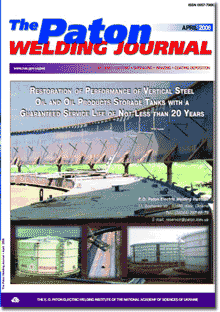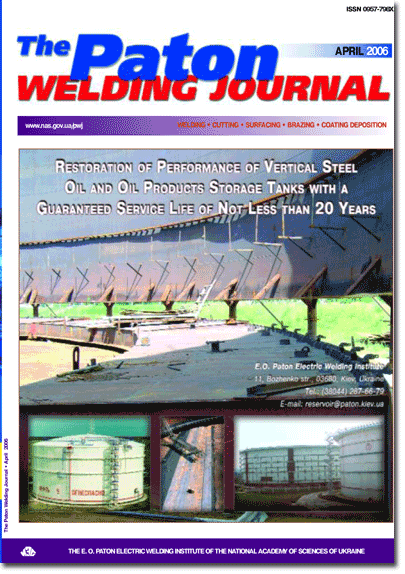

| SCIENTIFIC AND TECHNICAL | |
| Makhnenko V.I., Garf E.F., Rimsky S.T., Galinich V.I., Makhnenko O.V., Yukhimets P.S., Bubnov V.M., Tusikov E.K. and Varenchuk P.A. Welded freight bogie bolster project | 2 |
| The possibility of making welded freight bogie bolsters to compete with traditional cast ones is considered. It is shown that making of a welded structure, for which the cyclic load plays a decisive role, requires an integrated approach based on development of optimal designs of units and manufacturing technologies. | |
| Sterenbogen Yu.A., Vasiliev D.V., Demchenko E.L. and Novikova D.P. Role of peak stresses in formation of cold cracks in welded joints of hardenable steels | 9 |
| The paper presents analysis of the most important factors promoting cold cracking in welded joints of hardenable steels. It is shown that the most important components causing cold cracking are «peak» stresses in as-hardened metal structure and level of hydrogen content in points of local «peak» stresses. | |
| Yushchenko K.A., Chervyakov N.O. and Kalina P.P. Energy characteristics of low-amperage arcs | 17 |
| Energy characteristics of low-amperage arcs were studied. It was established that the low-amperage arcs in argon-arc welding are characterised by a higher (3Д5 times) concentration of heat flow, compared with arcs in plasma-arc cladding. Heat input and heat flow concentration are the main parameters allowing a wide-range control of the weld pool formation and strained state of the HAZ metal. | |
| Borisov Yu.S., Kislitsa A.N. and Vojnarovich S.G. Peculiarities of the process of microplasma wire spraying | 21 |
| Technology for microplasma spraying of coatings provides a small size of the spraying spot (several millimetres), is characterised by small dimensions of the equipment involved, and a low level of noise. Microplasmatron with a special wire feed device was designed to use wire as a source material for spraying. Structure and properties of coatings produced by the microplasma method using Mo, W, Ti, NiДCr, Al, brass and steel wire were investigated. The investigation results prove the possibility of applying this method for production of dense coatings with a spraying spot ranging from 3 to 8 mm. | |
| INDUSTRIAL | |
| Gehani M.L. Indian welding industry: current scenario and prospects | 26 |
| Considered are the state-of-the-art and future prospects of welding production in India, as well as the current status of international cooperation in the field of welding. The data on volumes of production and utilisation of steel and welding consumables are given. Main welding processes applied in India are reviewed. Prospects of development and application of power supplied are considered. | |
| Lopota V.A., Turichin G.A., Valdajtseva E.A., Malkin P.E. and Gumenyuk A.V. Computer system of electron beam and laser welding modeling | 29 |
| System of engineering computer analysis of laser, electron beam and hybrid welding LaserCAD is described, which allows predicting the weld pool shape and dimensions, structure and properties of weld and HAZ metal. The system is based on physically adequate numerical-analytical models of laser and electron beam treatment processes, contains databases on materials and equipment, and has user-friendly interface. | |
| Kisilevsky F.N., Dolinenko V.V. and Nikiforov A.Yu. Application of object-oriented design in development of welding TPACS | 32 |
| Status of guidelines on development of welding automated control systems is analyzed. The possibility is shown of using object-oriented design in development of complex welding TPACS. | |
| Matveev V.V. Economic effectiveness of railway wheel profile restoration | 35 |
| Quantitative evaluation of the influence of various factors on the effectiveness of wheel profile restoration by cladding, and, in particular, after annealing of the rolling surface hardened in operation. Effectiveness of wheel profile restoration is increased by applying annealing of the rolling surface, multi-electrode cladding and heat treatment of the clad and turned wheels. | |
| Kvasnitsky V.F., Kostin A.M., Romanchuk N.P. and Chernov S.K. Efficient organisational structures for training welding specialists for ship building | 39 |
| The article describes positive experience of establishment and efficient forms of activity of a regional centre for training welding fabrication specialists for ship building in Ukraine. | |
| BRIEF INFORMATION | |
| Kondratiev I.A., Ryabtsev I.A. and Chernyak Ya.P. Flux-cored wire for surfacing of maraging steel layer | 41 |
| Described is a new flux-cored wire PP-AN204 that provides deposited metal of the type of maraging steel with the Fe-Ni-Mn-Si-Mo alloying system. Hardness of the as-deposited metal is HRC 20-30, which allows its easy cutting, while after tempering its hardness grows to HRC 50. After tempering, the deposited metal is characterised by high hot hardness, thermal stability and wear resistance in friction of metal on metal at increased temperatures. Therefore, it can be recommended for hardening of working surfaces of complex-configuration die tools. | |
| Lebedev V.A. and Pritula S.I. Modern mechanisms of electrode wire feed in machines for mechanized welding, surfacing and cutting | 44 |
| Considered are current developments in the field of electrode wire feed mechanisms for welding, surfacing and cutting of steels and aluminium alloys. Classification of the main types of feed mechanisms is given. Of particular interest for welding specialists are the mechanisms that feed electrode wire with controlled non-stationary character of movement (intermittent, modulated or pulsed feed). Advantages and drawbacks of some ingenious designs of the pulsed mechanisms are considered. | |
| Thesis for scientific degree | 47 |
| Patents in the field of welding production | 48 |
| Developed at PWI | 47 50 |
(You are viewing the simplified file contents)
The cost of subscription/purchase order journals or individual articles
| Journal/Currency | Annual Set | 1 issue printed |
1 issue |
one article |
| TPWJ/USD | 384 $ | 32 $ | 26 $ | 13 $ |
| TPWJ/EUR | 348 € | 29 € | 24 € | 12 € |
| TPWJ/UAH | 7200 UAH | 600 UAH | 600 UAH | 280 UAH |
| AS/UAH | 1800 UAH | 300 UAH | 300 UAH | 150 UAH |
| AS/USD | 192 $ | 32 $ | 26 $ | 13 $ |
| AS/EUR | 180 € | 30 € | 25 € | 12 € |
| SEM/UAH | 1200 UAH | 300 UAH | 300 UAH | 150 UAH |
| SEM/USD | 128 $ | 32 $ | 26 $ | 13 $ |
| SEM/EUR | 120 € | 30 € | 25 € | 12 € |
| TDNK/UAH | 1200 UAH | 300 UAH | 300 UAH | 150 UAH |
| TDNK/USD | 128 $ | 32 $ | 26 $ | 13 $ |
| TDNK/EUR | 120 € | 30 € | 25 € | 15 € |
AS = «Automatic Welding» - 6 issues per year;
TPWJ = «PATON WELDING JOURNAL» - 12 issues per year;
SEM = «Electrometallurgy Today» - 4 issues per year;
TDNK = «Technical Diagnostics and Non-Destructive Testing» - 4 issues per year.


